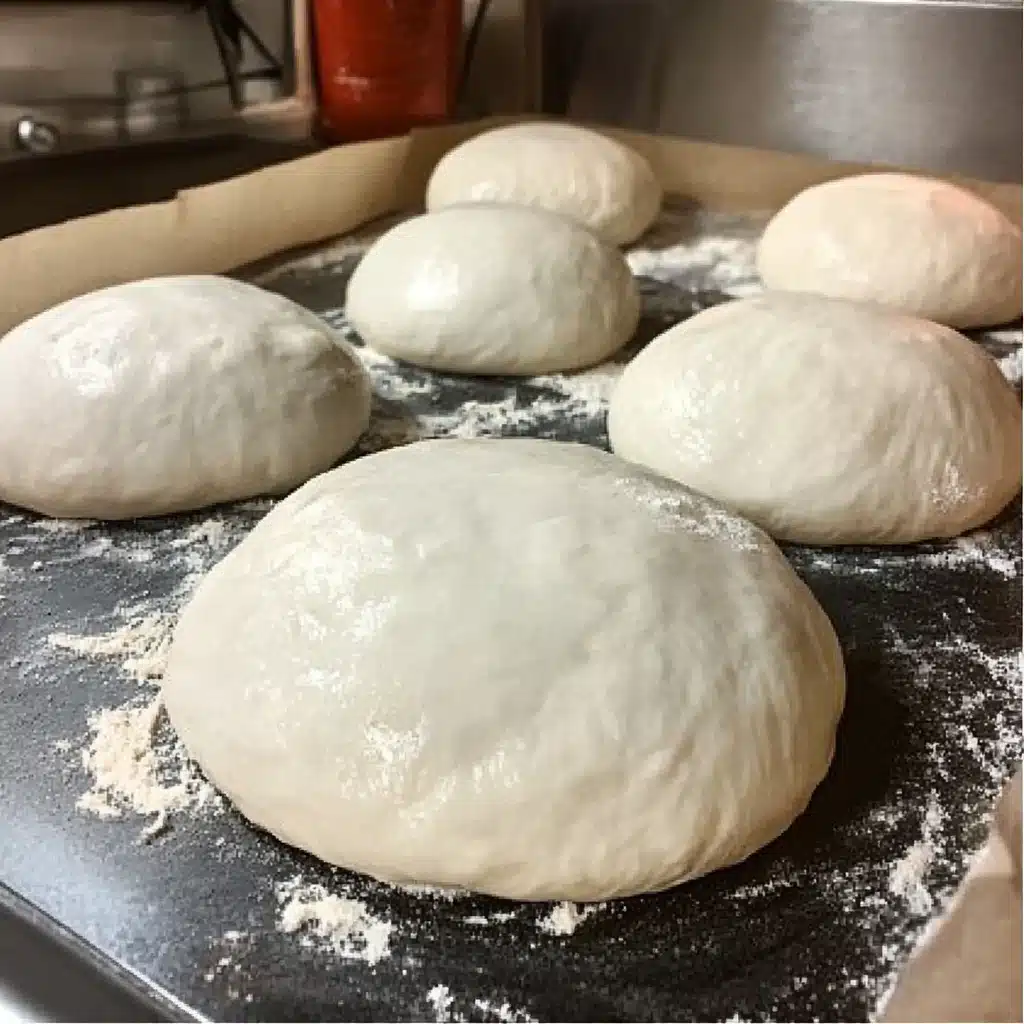There’s nothing quite like the magic of artisan pizza dough—crispy on the outside, airy and chewy inside, and perfectly blistered from a hot oven. Whether you’re planning a pizza party, dreaming of the ultimate BBQ chicken pizza, or simply craving a homemade slice, this dough delivers that authentic, pizzeria-quality bite right from your own kitchen.
Unlike quick-rise recipes, artisan dough develops its signature flavor and texture through time. With the right ingredients, a little patience, and the proper technique, you can create a beautifully structured dough that works as a base for all kinds of homemade pizza recipes. If you’ve tried other crusts but weren’t impressed, this just might be the best pizza dough recipe you’ll ever use.
Let’s dive into the secrets behind mastering artisan-style pizza at home.
Table of Contents
What Is Artisan Pizza Dough and Why It’s Worth the Effort
Artisan pizza dough is made using traditional techniques—long fermentation, high-hydration ratios, and quality ingredients. The result? A crust that is:
- Bubbly and blistered
- Crispy on the edges, soft and chewy inside
- Full of flavor, thanks to the slow rise and gluten development
What sets it apart is its structure and depth of flavor. You don’t need commercial ovens or fancy tools to make it. All you need is the right formula, time, and a few kitchen basics.
Ingredients You’ll Need for the Best Pizza Dough Recipe
This simple list of ingredients is what gives this dough its artisan qualities:
- 500 grams (about 4 cups) bread flour – for a strong gluten structure
- 375 grams (1½ cups + 1 tbsp) water – cool, for a high hydration dough
- 2 teaspoons salt
- 1½ teaspoons instant yeast
- 1 tablespoon olive oil (optional)
- Semolina or cornmeal, for dusting the peel
Use bread flour for higher protein content, which helps develop chewiness. You can substitute all-purpose, but the texture will be slightly softer.
Step-by-Step: How to Make Artisan Pizza Dough from Scratch
Step 1: Mix the dough
In a large bowl, whisk together the flour, salt, and yeast. Slowly pour in the water and stir until a shaggy dough forms. If using olive oil, mix it in last.
Step 2: Rest and stretch
Cover the bowl with a damp towel and let the dough rest for 30 minutes. Then do a series of stretch and folds every 30 minutes (2–3 times). This builds gluten without kneading.
Step 3: Bulk ferment
Cover and let the dough rise at room temperature for 8–12 hours. It should double in size and be bubbly on the surface.
Step 4: Divide and shape
Transfer the dough to a floured surface. Divide into 2–4 equal balls, depending on your pizza size preference. Place in oiled containers, cover, and refrigerate for 12–72 hours.
Step 5: Final rise
Remove from the fridge 1–2 hours before baking. Let the dough rest at room temperature until puffed and relaxed.
Step 6: Shape and bake
Gently stretch the dough into rounds (avoid using a rolling pin). Bake on a preheated pizza stone or steel at 500–550°F (260–290°C) for 6–9 minutes, until the crust is golden and blistered.
Use this dough to create Pizza Rolls, classic Margherita, or a bold BBQ Chicken Pizza—all on the same base.
Understanding Hydration, Fermentation, and Gluten in Pizza Dough
Hydration: Artisan dough typically ranges from 70–80% hydration. Higher water content means a more open crumb and better rise in the oven.
Fermentation: Long fermentation (cold or room temp) develops flavor. The longer the dough ferments, the more complex the flavor.
Gluten: Strong flour + rest time + folds = elastic dough. Gluten development is essential for shaping and rise.
Learning to read your dough takes a little practice, but soon you’ll be able to tell when it’s perfectly proofed.
Tips for a Crispy, Chewy, and Bubbly Pizza Crust
- Use a pizza stone or steel: Preheat it for at least 45 minutes for that oven spring
- High oven temperature: Artisan crusts love heat. Go as high as your oven allows
- Avoid rolling the dough: This pushes out air and flattens the bubbles
- Use minimal toppings: Too much moisture can weigh down and sog the crust
- Dust with semolina: Prevents sticking and adds texture
Want more pizza creations? Explore our Pizza Recipes Dough collection for delicious topping ideas and flavor combinations.
Artisan Pizza Dough vs. Traditional or Quick Pizza Dough
| Feature | Artisan Pizza Dough | Quick Dough |
|---|---|---|
| Rise Time | 12–72 hours | 30–90 minutes |
| Texture | Chewy, bubbly, complex | Soft, bread-like |
| Flavor | Deep, slightly tangy, fermented | Mild |
| Best For | Neapolitan, wood-fired, BBQ chicken | Flatbreads, weeknight dinners |
While both are great depending on your needs, artisan dough truly shines when you want the best possible crust.
Creative Uses: From Pizza Rolls to BBQ Chicken Pizza
Once you’ve mastered the dough, the possibilities are endless:
- Pizza Rolls: Roll out thin, fill with sauce and cheese, then roll and slice before baking
- BBQ Chicken Pizza: Top with BBQ sauce, cooked chicken, red onion, and fresh cilantro
- Flatbread sandwiches: Grill small rounds and fill with roasted veggies and hummus
- Garlic knots: Use scraps to twist and brush with garlic butter
- Stromboli or calzones: Fill and fold for handheld versions of your favorite pies
For more ideas, check out our Pizza Party Tips and Recipes for a full spread.
How to Store, Freeze, and Thaw Homemade Pizza Dough
Make extra dough now and enjoy artisan pizza later:
Refrigerate: Store dough balls in sealed containers or bags for up to 3 days
Freeze: Wrap individual dough balls tightly in plastic and freeze for up to 3 months
Thaw: Transfer frozen dough to the fridge the night before, then bring to room temp before baking
Letting the dough relax and warm up is key to stretching it without tearing.
Tools You’ll Need for the Ultimate Homemade Pizza Experience
- Digital kitchen scale – accuracy matters
- Mixing bowls – glass or stainless steel
- Bench scraper – for dividing dough
- Pizza peel – to transfer to the oven
- Pizza stone or steel – essential for crispy crust
- Dough proofing containers – optional but helpful
If you don’t have a pizza stone, an upside-down baking sheet can work in a pinch.
Common Mistakes to Avoid with Artisan Pizza Recipes Dough
- Underproofing – dough should be airy and relaxed, not dense
- Overworking the dough – handle gently to preserve bubbles
- Skipping preheat – oven must be fully hot for proper baking
- Too many toppings – leads to soggy or undercooked crust
- Using too much flour – can dry out or toughen the dough
Follow these tips and your homemade artisan pizza will rival your favorite pizzeria.
Pizza Party Prep: Making Dough in Advance for Crowd-Pleasing Pies
Planning a pizza party? Here’s how to scale your artisan dough:
- Make the dough 2–3 days in advance for best flavor
- Portion the dough into individual balls and refrigerate
- Set up a topping bar: sauces, cheeses, proteins, veggies
- Use two stones or bake one pizza at a time and keep warm in the oven
- Let guests shape and top their own pizzas—it’s fun and interactive
Pair with salads, sparkling water, or fruit drinks for a casual, crowd-friendly meal.
Serving Ideas: Homemade Pizza Recipes You Can Build on This Dough
Once your dough is ready, try these creations:
- Classic Margherita: Tomato sauce, mozzarella, basil
- Veggie Supreme: Mushrooms, bell peppers, spinach, onions
- Four Cheese: Mozzarella, fontina, parmesan, goat cheese
- Spicy Pepperoni: Thinly sliced pepperoni and red chili flakes
- Hummus Flatbread: Topped post-bake with arugula and chickpeas
Need gluten-free alternatives? Try our Healthy Starch Side Dishes or Chapati-Inspired Bakes for creative spins.
Chapati vs. Pizza Dough – Can They Be Substituted?
While both are flour-based flatbreads, chapati and pizza dough are quite different:
- Chapati uses whole wheat flour, water, and no yeast
- Pizza dough relies on gluten development and fermentation
- Texture: Chapati is soft and pliable; pizza dough is chewy and crusty
- Baking methods: Chapati is cooked on a griddle, not baked
While you can’t directly substitute chapati for pizza crust, chapati-inspired flavors (like cumin, garlic, or ghee) can inspire flatbread pizzas or naan-style pies.
Try This Artisan Pizza Dough and Elevate Pizza Night
Once you try this artisan pizza dough, there’s no going back to store-bought crusts or shortcuts. With just flour, water, yeast, and time, you can create an unforgettable pizza that rivals any restaurant.
Give this a try for your next pizza night and watch the crust bubble, crisp, and shine with every slice. Don’t forget to tag your creations and subscribe for more pizza recipes homemade from scratch.
PrintArtisan Pizza Dough – The Ultimate Homemade Crust for Pizza Night
- Total Time: 30 minutes (+ 24–72 hr rest)
- Yield: 2 pizza dough balls 1x
- Diet: Vegetarian
Description
Artisan Pizza Dough gives you that chewy, crispy, and airy crust found in your favorite pizzerias—made easily at home with just flour, water, yeast, and salt. Perfect for pizza night, rolls, or flatbreads.
Ingredients
- 500 grams (about 3 ¾ cups) bread flour
- 375 grams (about 1 ½ cups plus 2 tablespoons) water, at room temperature
- 10 grams (2 teaspoons) sea salt
- 1 gram (¼ teaspoon) active dry yeast or instant yeast
Instructions
- In a large bowl, mix flour and yeast. Add water and stir to form a shaggy dough. Let rest 30 minutes.
- Sprinkle in salt and knead until smooth and elastic (8–10 mins by hand or 6 mins in a mixer).
- Cover and rest at room temp 30 minutes. Perform stretch-and-folds every 30 minutes for 3 rounds.
- Cover and refrigerate the dough for 24–72 hours for cold fermentation.
- Remove from fridge, let come to room temp. Divide into 2 balls and shape gently.
- Let rest 1–2 hours before baking.
- Preheat oven with pizza stone or steel at 500–550°F (260–290°C). Stretch dough by hand, top as desired, and bake 7–10 minutes until golden and bubbly.
Notes
- Do not roll the dough—hand stretch only to preserve air bubbles.
- Preheat your oven and stone/steel for at least 45 minutes before baking.
- Use bread flour for best chewiness and structure.
- Less is more—avoid overloading with sauce or toppings.
- Cold ferment for up to 72 hours for richer flavor.
- Prep Time: 20 minutes
- Cook Time: 10 minutes
- Category: Main Dish
- Method: Baking
- Cuisine: Italian
Nutrition
- Serving Size: 1 pizza (per dough ball)
- Calories: 600
- Sugar: 1g
- Sodium: 800mg
- Fat: 2g
- Saturated Fat: 0g
- Unsaturated Fat: 2g
- Trans Fat: 0g
- Carbohydrates: 125g
- Fiber: 4g
- Protein: 16g
- Cholesterol: 0mg
Keywords: Artisan Pizza Dough, Homemade Pizza Crust, Chewy Pizza Dough, Best Pizza Dough Recipe, How to Make Pizza Dough







